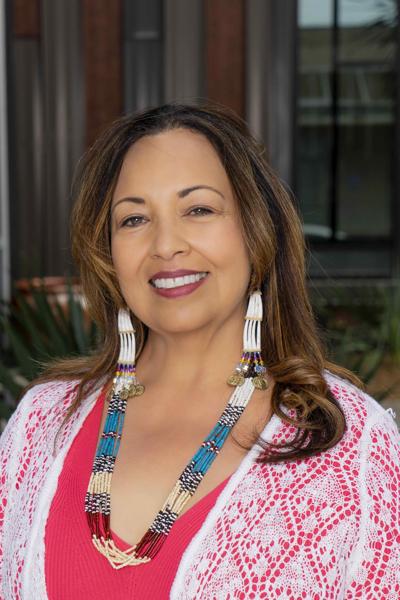As Principal Chief, Lora Ann Chaisson represents the United Houma Nation locally and internationally. She was born in Houma and now lives in Pointe-au-Chien, areas heavily damaged by Hurricane Ida in 2021. She just returned from making a presentation in New York at the United Nations’ Permanent Forum on Indigenous Issues. And she’s represented the tribe at Jazz Fest, both as a volunteer and officially, for nearly four decades. She does a food demonstration at the Food Heritage stage every year and also does craft demonstrations in the Folklife Village. For information about the United Houma Nation, visit unitedhoumanation.org. For info about cultural happenings at Jazz Fest, see nojazzfest.com.
Gambit: How did you get involved at Jazz Fest?
Lora Ann Chaisson: I did volunteer work at first, and helping out at the Kids Tent. At one time, people used to drop their kids off at the kids' area. It’s totally different now. We used to make a palmetto house. My cousin Grayhawk (Perkins) was one of the managers. He’s a musician and a storyteller for our tribe. We built a palmetto hut and kids helped. I used to bring my boys there.
We had always tried to get a Native American Village in Jazz Fest. We were like, “We’re first people. New Orleans was our territory. Let’s have something.” We were able to get that. We had a stage and big-time tribal musicians and local tribal artists. We had demonstrations of powwows. It was in a circle. We had the food booth there. We did Indian tacos and fry bread and the traditional foods. Then Hurricane Katrina hit, and it was taken away. After Katrina, they switched it to the area where we are now.
Gambit: How did you get involved in the food side of the festival?
Chaisson: I started demonstrating food at the Zatarain’s Stage when it was outside. They did away with that. After Covid, that never came back.
Ms. Loretta Oden is the oldest Native American chef. She is still working. She’s from the Citizen Potawatomi Nation. She still cooks and runs the restaurant 39 Tribes in the First Americans Museum in Oklahoma City.
She came to Jazz Fest. She had done a cooking series on PBS (“Seasoned with Spirit: A Native Cook’s Journey”). She and I were on one of the first episodes together. So Jazz Fest invited her to come do a demo of traditional foods. We came in together. I did alligator sauce piquante. That’s how I started.
Every year, I started doing a food demonstration. I would do one of our traditional dishes. I did traditional file gumbo. A gumbo without a roux. That’s indigenous to our people. We use the leaves of sassafras trees. In August, we start harvesting and drying it and then grinding it. That’s what makes it thick.
I do corn maque choux. I do the three sisters dish. That’s corn, beans and squash. It’s one of the oldest dishes in the U.S. as far as Indigenous people. Or I would do something with blackberries or pumpkin. That’s all Indigenous foods. Loretta and I do a lot of workshops on Indigenous foods. It’s why I love chef John Folse. He always makes sure that contributions to New Orleans food start off with native foods. He always makes sure that’s recognized.
Sweet potato, tomatoes and chocolate are all Indigenous foods. Strawberries, sunflowers and sunflower oil, corn, beans. All these things are Indigenous.
All tribal people do fry bread. Throughout the United States they all do fry bread. It’s not a traditional traditional dish. The government imposed the flour on us. So the tribal people started creating these breads.
Gambit previews the first weekend of Jazz Fest 2024.
Gambit: What dish are you demonstrating?
Chaisson: I am taking fry bread and sweet potato and using the same ingredients I use when I make sweet potato pie. I take those ingredients and mix it with the fry bread, and make a dough and wrap it around the strawberry and fry it. Nothing healthy, but it’s good.
This year is a little different. It’s like a chef competition. I guess they’ve been watching a lot of Food Network. Usually, I have to cook for 100 people. I am bringing some sugarcane and some honey to use as a topping.
That dish was created after Hurricane Ida. We lost everything. We didn’t have prep space. We had to use only what we had at the time. Our tribe was devastated — all of our tribal communities in Houma, Pointe-au-Chien, Dulac, Lafourche. We had to create things on the spot. That’s something we created for Jazz Fest. The tribe sells that at the booth at Jazz Fest. The booth is our biggest tribal fundraising for the year.
We make the fry bread on the spot and do demonstrations. It’s popping hot.
The Indian taco is fry bread with ground beef, lettuce, tomatoes and cheese and a homemade sauce. I do mine a little different than they do. I use tomato, onions, cilantro and salt and pepper. It’s like a salsa. But the tribe does more like a picante sauce.
The first weekend, I’ll be there Thursday for the demonstration. The second weekend, I’ll be there every day. I am doing a basket-weaving demonstration. I am a traditional weaver. I use palmetto leaves. I am looking forward to it. I have been traveling. Basket weaving is my therapy.
Mother of Pearl is a gem in more ways than one.







